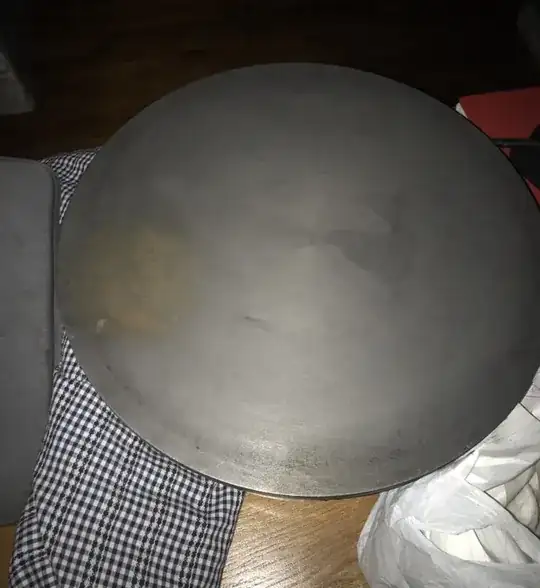I have a Krampouz crepe machine made of cast iron. Someone rested what looks like a hot mug of tea on top of it, and now it has a dark brown burn patch. Does this mean it will no longer work, or is there a way I can remove this?
- 121
- 1
- 3
-
I really hope it wasn't this one: https://www.katom.com/042-KCME1RND620.html?gclid=Cj0KCQjwl4v4BRDaARIsAFjATPnks5Im-KuMM4OQQbz_2DwVH_nUaAx1cc3yO5uZHBCzcxeGQ2IZL3waAlKSEALw_wcB – Kevin Jul 06 '20 at 23:45
1 Answers
This is not a burnt patch, cast iron doesn't burn. It is almost certainly a rust patch.
Since the surface comes into direct contact with food, you cannot use the rust removers sold in home improvement stores. You need to remove it with lye - you can try a mechanical stripping too, but that is unlikely to get all tiny specks of rust, unless you get serious about it and use a dremel attachment until you bite into the blank metal. See also my answer here about removing rust from cast iron.
Once you have stripped that part (or all of the seasoning, if you use lye) you will need to reseason. Since this is a crepe maker, you don't have to do much with multiple layers etc., just enough to seal the surface against rust until the next batch of crepes you make. Making more batches will give you an even better surface.
Above, I said "almost sure" that this is rust. Since this is only a photo, there is a tiny possibility that this is stuck-on dirt which looks like rust. If you think that this might be the case, you could try removing it with an abrasive cleaner, or with a metal sponge. But since this will be a lot of work and the chance is small that this is not rust, you can just treat it like rust from the beginning.
-
1LONG before I would try lye, I would try salt. NOTE: Salt is only a chemical reactive risk to iron if left on (or soaked) in it. Dampen a paper towel, load it up with the salt dry, and try to use it to abrade it away. Salt in crystal form has a Moes hardness of 2 to 2.5, while Iron is up at 4. So the salt will (mostly) leave the iron alone, but do a good job of banging against whatever residue is there, even if it's one of the flaking iron oxides. _Keep the salt as dry as you can_----the damp is just to have it "hold" to the towel. When you're done, rinse obsessively while rubbing. – tgm1024--Monica was mistreated Jul 07 '20 at 18:22
-
-
@MattKrause acid on a cast iron pan increases rust, doesn't remove it. – rumtscho Jul 08 '20 at 07:31
-
@tgm1024--Monicawasmistreated there are better abrasives than salt, including ones that are softer than the pan. But in fact, you want to have something harder than the pan, so you can really sand the upper layer away, if you don't want to remove the rust with lye. It's tons of hard work though. – rumtscho Jul 08 '20 at 07:39
-
1@rumtscho, are you sure about that? It's a pretty common method for removing rust from tools (etc): https://chemistry.stackexchange.com/questions/4732/chemically-removing-rust-without-leaving-any-unwanted-residues It will attack the seasoning (and, eventually, the metal too), but the rust should come off first. – Matt Krause Jul 08 '20 at 14:05
-
@rumtscho, You *don't* want something harder than the pan yet, you want something ideally slightly softer. Remember, the person isn't 100% sure what this stuff actually is, so working with the edges of salt crystals would be a painless 1st step. You also have the added reassurance that it's inherently food safe in case you don't rinse/remove it afterwards perfectly. Regarding acids: Different acids react differently with iron. For example, mild Acetic Acid solutions (vinegar) are great at removing rust (it's very common to use it on tools). Phosphoric acid does too, but I've never used it. – tgm1024--Monica was mistreated Jul 09 '20 at 13:59
-
@tgm1024--Monicawasmistreated if it's softer than iron, it won't be able to remove any of the metal. And since rust is deep in the crevices of the iron, you have to sand away a bit of the metal if you want to remove it. Salt cannot remove stuff from cast iron well, that's why it is used on seasoned cast iron pans as a cleaning method - it leaves the seasoning intact. I have tried vinegar on a cast iron pan and it rusted terribly all over, so I can't recommend it at all. – rumtscho Jul 10 '20 at 09:57
-
@rumtscho, no, a drillbit for instance is far far softer than pine, but as you use it it becomes dull. Let's just have her try it to see. It's easy, and if some rubbing with the salt crystals takes some of the mark away (you will see it darken the papertowel) then it's a win. Also, I've used it on stainless steel and after strong rubbing the stainless (far harder ~Mohs 5.5-6.5ish) starts to darken the salt. – tgm1024--Monica was mistreated Jul 11 '20 at 14:04
-
@rumtscho, and splitting the issues up: I don't know what to tell you about vinegar other than to google around and you'll find it among the first things that people reach for to remove rust from iron and steel. I've soaked a (non-valuable) antique axe head in it and it resulted in all the rust gone. I've done this with saws, bolts, etc. If the OP needs to try this after the salt fails, then fold a papertowel a few times so it's thicker than normal, soak it in vinegar, lay it over just the stained part, and place plastic wrap over it. Check it periodically. – tgm1024--Monica was mistreated Jul 11 '20 at 14:12
-
@rumtscho, here's a fun timelapse: [Watching rust fall off in vinegar over 16 hours](https://www.youtube.com/watch?v=EuIa8h4d0RY). – tgm1024--Monica was mistreated Jul 11 '20 at 14:17